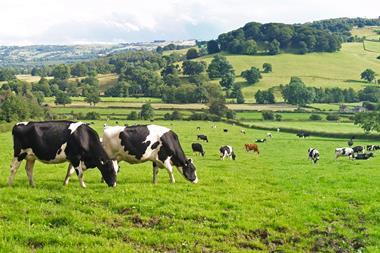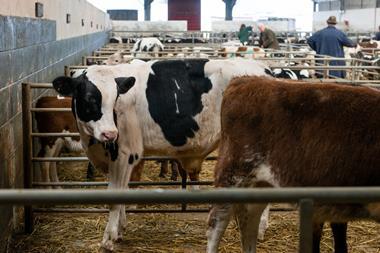Beef producers: Commitment to mainland surprisingly successful
The beef industry might seem to still be in deep
crisis but resurgence of sales to the British multiples has been nothing short of spectacular from a supply resource now world class
says Mike Ingham
Wholesome grass and hard graft give livestock farmers in Northern Ireland a reputation for rearing some of Europe's highest quality cattle. Regulatory influences are powerful and frequently damaging, yet long experience of coping with intrusive and self-contradictory officialdom is a competitive advantage in the EU meat market as changes in the subsidy system create risks of new supply bottlenecks.
If there is a sense of injustice in NI's beef producing community, it is easy to understand. BSE was never present in the herd on anything like the scale demonstrated on the mainland. Yet the effects were far more devastating than anywhere else in the UK.
And, ironically, the province was a much more genuine exporter than the mainland industry. NI beef certainly did reach shoppers in mainland Europe in quite substantial volumes.
Market developments culminating in a major deal to supply Dutch chain Albert Heijn deal resulted, by the mid '90s, in NI's beef and cattle prices regularly topping the UK average.
This was due to purchaser perceptions of the province as having a cleaner, safer beef producing environment than mainland Britain, with a more rigorous hygiene and quality control regime on the farms and in its processing plants. Certainly NI was years ahead of mainland Britain in establishing a cattle identification and traceability system.
Legal clearance for resumed shipments to continental and third country buyers proved almost meaningless sales did not materialise, because a combination of over-valued sterling and the costs of meeting the strict official criteria for export eligibility of the cattle and beef priced the province's meat out of its former markets. Further disappointment came with the discovery of alleged flaws in the export verification system, leading to effective reimposition of the ban.
So the superficial impression is of a beef industry still in deep crisis. Export business to the continent is still at a standstill. Cattle prices are again much lower than on the mainland, and herds appear to be contracting.
"It is no accident that more beef farmers are giving up," says Harry Marquess of the producer lobby group the National Beef Association. "Beef cow numbers have dropped by 20,000 head or 6% over the past two years, and replacement heifers by an alarming 16,000 head or 34%." Marquess offers a blunt explanation: "The factories' short sightedness."
The NBA's grievance is beef cattle prices being "manipulated" by the processors to keep the NI market at least 10% lower than on the mainland, causing erosion of the producer base, yet a simultaneous surge of livestock imports from the Republic to maintain plant throughputs.
However, this dispute hints at the largely hidden strength of NI's beef sector. Why are the plants such keen buyers of imported cattle if their trade has been hit so hard as commonly believed? Their tiny domestic market, within the province, cannot provide an answer.
The reality seems to be a quiet but spectacular resurgence of sales to the British multiples. If this is true, it is an extraordinary accomplishment. The industry's first response to the EU ban was, of necessity, to shift former EU and third country destination beef into the weakest parts of the British wholesale market and second tier direct customers such as foodservice operators, cheap burger makers and minor multiples.
Now, as the performance of ABP, Foyle, Dungannon and less well known processors is beginning to demonstrate, the sector is being taken much more seriously by Tesco, Sainsbury and the other retail heavyweights in Britain.
Price is clearly likely to remain a highly contentious issue, producers complaining they are paid less than mainland farmers for arguably better quality cattle, while some processors in the Republic grumble as their procurement costs are forced up by the drain of stock north across the border.
But from the perspective of British retailers and further processors or meat product manufacturers, heavy investment in sophisticated plant, equipment and management systems within the NI industry (including at the moment a lot of spending on IT) has given this country an unexpected world class supply resource within its own borders.
Disappointment at the failure of the export market to reopen as many in the NI beef industry had hoped is widespread, but less so than outsiders would expect. And for some processors, commitment to expanding within the UK market rather is paying off better than expected.
Anyone aware of Larry Goodman's reputation will not be surprised to learn his ABP Newry plant is among the success stories. Management at this outpost of the Irish meat magnate's business empire has taken the principles familiar to suppliers and customers of Anglo Beef Processors in Britain and applied them even more rigorously than on the mainland.
The Partnership in Livestock movement, ABP's tripartite relationship with beef farmers and Sainsbury, has been developed at Newry into the biggest producer group in the UK. It has more than 2,000 members, and ABP claims the virtues of the home market have been the focus of all its activities.
"We are not going to stand still, waiting for exports to solve the industry's problems," says ABP Newry general manager Colin Duffy. Instead, new avenues have to be explored to improve Newry's offer and to help its producer suppliers. "We have special products to offer because of our extensive [grass-based production] systems. We are examining the use of IT to allow our farmers fast access to grading information, not only for their own cattle but also against the mean of all producers. Genetic improvement and niche markets will go hand in hand."
Duffy mentions the possibility of encouraging high quality bull beef production. These animals were wanted for Europe before the BSE crisis halted exports, but UK supermarkets have always been assumed not to want these beasts. In fact, there has long been greater acceptance than major retailers admitted in public, and now the acknowledgement is becoming less uncomfortable.
"UK multiples are recognising the value of these animals," says Duffy. "And they offer, for some of our producers, a way around the limitations of the new CAP reforms."
Mention of EU agriculture policy reform makes most UK meat buyers shudder, but awareness of the implications is increasing within the multiples' purchasing departments.
One theme of subsidy system overhaul is encouragement of lower stocking densities, partly for environmental reasons.
And one likely consequence is a shortage of high quality cattle, rather like the frequent scarcities of good butchers' lambs despite apparently abundant supply, the result of producer responses to subsidy changes.
As Duffy points out, "for many farmers the concept of one bull punch for subsidy at 10 months, with the best finished for processing at 16 months, would be attractive compared to heifer and steer beef at 24 months, which eats into stocking density rules."
Thanks to Northern Ireland's small production units and short lines of communication there are opportunities for turning these administrative complexities into competitive advantages with rapid reaction through the supply chain.
{{Z SUPPLEMENTS }}
Close menu
- Home
- Retail & Wholesale
-
Products & Suppliers
- Back to parent navigation item
- Products & Suppliers
-
Product Categories:
- Back to parent navigation item
- Product Categories:
- Alcoholic drinks
- Bakery
- Cereals & breakfast
- Cheese
- Chicken & poultry
- Chocolate
- Confectionery
- Crisps, nuts & snacks
- Dairy
- Fish
- Fresh produce
- Frozen
- Household
- Meat
- Own Label
- Sauces & condiments
- Seasonal
- Soft drinks
- Vaping
- Vegan & plant-based
- World foods
- Suppliers
- People
- Reports & Data
-
Topics A-Z
- Back to parent navigation item
- Topics A-Z
-
Popular topics:
- Back to parent navigation item
- Popular topics:
- Cost of living crisis
- Crime
- Deposit Return Schemes
- Finance
- Government & Regulation
- Health
- Inflation
- Loyalty
- Marketing
- Mergers & Acquisitions
- New Product Development
- Sourcing
- Supply chain
- Sustainability & environment
- Technology
- Ultra Processed Foods
- Vaping
- A-Z all topics
- Content by type:
- Events
- Subscribe now
Sign in to comment on this article
Not logged in before? Register for FREE guest access today.
You will be able to:
- Read more stories
- Receive daily newsletters
- Comment on stories
Advert



















No comments yet